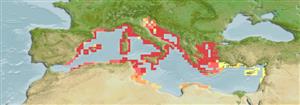分類 / Names
共通名の | 類義語 | Catalog of Fishes (gen., sp.) | ITIS | CoL | WoRMS | Cloffa
条鰭類 >
Perciformes (Perch-likes) >
Blenniidae (Combtooth blennies) > Salariinae
Etymology: Salaria: Latin, salar, salaris = trout (Ref. 45335).
環境 / 気候 / 範囲
生態学
; 海; 新鮮な水; 汽水性の 底生の; pH range: 6.5 - 7.5; dH range: 8 - 12. Subtropical; 18°C - 24°C (Ref. 13371), preferred ?; 47°N - 32°N, 7°W - 37°E
Europe and Africa: Africa: Rivers and brooks in Algeria and Morocco flowing to the Mediterranean; including Israel. Europe: Albania, Croatia, France, Greece, Italy, Montenegro and Spain (Ref. 26100); Portugal (Ref. 13612). Asia: Turkey.
サイズ / 重さ / 年齢
Maturity: Lm ? range ? - ? cm
Max length : 15.4 cm TL オス/雌雄の選別がない; (Ref. 95757); common length : 8.0 cm TL オス/雌雄の選別がない; (Ref. 556)
背面の脊椎 (合計): 12 - 13; 背鰭 (合計): 16-17; 肛門の骨 2; 臀鰭: 16 - 19; 脊つい: 36. This species is distinguished from its congeners in European inland waters by the following combination of characters: a broad diagonal band of tiny dots running from eye backward and downward; branched cirrus above eye; head length 25-31% SL; upper jaw with 16-24 teeth, lower jaw with 16-20; A II,16-19; D XII-XIII,16-17 (Ref. 59043).
Adults occur in rivers and brooks (Ref. 4342), in relatively shallow water as well as in low altitude lakes (Ref. 30578), on stone bottom; in streams, deepest and fastest microhabitats are preferred and sometimes coastal lagoons with low salinity (Ref. 59043). A territorial species that lives up to 5 years (Ref. 59043). Adults feed on small benthic organisms, aquatic insects and pupae (Ref. 94105). Oviparous (Ref. 205). Females spawn for the first time at the end of the first year and spawning lasts up to 3 years but with most females dying at the end of the first spawning year. One female spawns up to 1,200 eggs (usually 200-300) in a single layer under a large stone; spawns several egg portions during the season. On the other hand, the males clean, fan and defend the eggs until hatching. Several females may spawn with one male, which may guard the eggs at different stages of development (Ref. 59043). Eggs are demersal and adhesive; eggs hatch in about a week (Ref. 205, 59043). Planktonic larvae until about 1.5 cm, are drifted to and remain in quiet pools or side arms of rivers (Ref. 59043). Populations are threatened due to pollution and water abstraction (Ref. 26100); most riverine populations affected by habitat alteration (especially siltation and alteration of stream morphology), and predation of exotic species. Presence of habitat suitable for the pelagic 'larval' stage downstream of spawning sites is a limiting factor; lacustrine population are apparently safer (Ref. 59043).
Life cycle and mating behavior
成熟 | 繁殖 | 放精 | 卵 | 生産力 | 幼生
Produces 200-300 eggs (Ref. 1672). Paternal care (Ref. 4342). Male cleans, fans and defends eggs until hatching. Several females spawn with one male, which may guard eggs at different stages of development. Eggs hatch in about a week (Ref.59043).
Bath, H., 1986. Blenniidae. p. 355-357. In J. Daget, J.-P. Gosse and D.F.E. Thys van den Audenaerde (eds.) Check-list of the freshwater fishes of Africa (CLOFFA). ISNB, Brussels, MRAC, Tervuren; and ORSTOM, Paris. Vol. 2. (Ref. 4342)
CITES (Ref. 94142)
Not Evaluated
Human uses
水産業: 興味がない; 水族館・水槽: 商業
より多くの情報
参考文献水産養殖水産養殖の紹介緊張遺伝子の対立遺伝子頻度遺伝病気行列Mass conversion
協力者画像Stamps, Coins音シガテラ(食中毒の名前)速度泳ぐ 型式カマOtoliths脳視覚
用具
特記事項
XMLをダウンロードして下さい
インターネットの情報源
